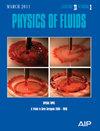Performance prediction and design optimization of a transonic rotor based on deep transfer learning
IF 4.3
2区 工程技术
Q1 MECHANICS
引用次数: 0
Abstract
Deep transfer learning is frequently employed to address the challenges arising from limited or hard-to-obtain training data in the target domain, but its application in axial compressors has been scarcely explored thus far. In this paper, a multi-objective optimization framework of a transonic rotor is established using deep transfer learning. This framework first pre-trains deep neural networks based on the peak efficiency condition of 100% design speed and then fine-tunes the networks to predict the performance of off-design conditions based on the small training dataset. Finally, the design optimization of the transonic rotor is carried out through non-dominated sorting genetic algorithm II. Compared to neural networks that are trained directly, transfer learning models can achieve higher prediction accuracy, particularly in scenarios with small training datasets. This is because the pre-trained weights can offer a better initial state for transfer learning models. Moreover, transfer learning models can use fewer samples to obtain an approximate Pareto front, making the optimized rotor increase the isentropic efficiency at both peak efficiency and high loading conditions. The efficiency improvement of the optimized rotor is attributed to the reduction of the loss associated with the tip leakage flow by adjusting the tip loading distribution. Overall, this study fully demonstrates the effectiveness of transfer learning in predicting compressor performance, which provides a promising approach to solving high-cost compressor design problems.基于深度迁移学习的跨音速转子性能预测与设计优化
深度迁移学习经常被用来解决目标领域训练数据有限或难以获得所带来的挑战,但其在轴流压缩机中的应用迄今为止还鲜有探索。本文利用深度迁移学习建立了跨音速转子的多目标优化框架。该框架首先基于 100% 设计转速的峰值效率条件对深度神经网络进行预训练,然后根据小型训练数据集对网络进行微调,以预测非设计条件下的性能。最后,通过非支配排序遗传算法 II 对跨音速转子进行设计优化。与直接训练的神经网络相比,迁移学习模型可以获得更高的预测精度,尤其是在训练数据集较小的情况下。这是因为预训练的权重可以为迁移学习模型提供更好的初始状态。此外,迁移学习模型可以使用更少的样本获得近似帕累托前沿,从而使优化后的转子在峰值效率和高负载条件下都能提高等熵效率。优化转子效率的提高归功于通过调整尖端负载分布减少了与尖端漏流相关的损失。总之,本研究充分展示了迁移学习在预测压缩机性能方面的有效性,为解决高成本压缩机设计问题提供了一种前景广阔的方法。
本文章由计算机程序翻译,如有差异,请以英文原文为准。
求助全文
约1分钟内获得全文
求助全文
来源期刊

Physics of Fluids
物理-力学
CiteScore
6.50
自引率
41.30%
发文量
2063
审稿时长
2.6 months
期刊介绍:
Physics of Fluids (PoF) is a preeminent journal devoted to publishing original theoretical, computational, and experimental contributions to the understanding of the dynamics of gases, liquids, and complex or multiphase fluids. Topics published in PoF are diverse and reflect the most important subjects in fluid dynamics, including, but not limited to:
-Acoustics
-Aerospace and aeronautical flow
-Astrophysical flow
-Biofluid mechanics
-Cavitation and cavitating flows
-Combustion flows
-Complex fluids
-Compressible flow
-Computational fluid dynamics
-Contact lines
-Continuum mechanics
-Convection
-Cryogenic flow
-Droplets
-Electrical and magnetic effects in fluid flow
-Foam, bubble, and film mechanics
-Flow control
-Flow instability and transition
-Flow orientation and anisotropy
-Flows with other transport phenomena
-Flows with complex boundary conditions
-Flow visualization
-Fluid mechanics
-Fluid physical properties
-Fluid–structure interactions
-Free surface flows
-Geophysical flow
-Interfacial flow
-Knudsen flow
-Laminar flow
-Liquid crystals
-Mathematics of fluids
-Micro- and nanofluid mechanics
-Mixing
-Molecular theory
-Nanofluidics
-Particulate, multiphase, and granular flow
-Processing flows
-Relativistic fluid mechanics
-Rotating flows
-Shock wave phenomena
-Soft matter
-Stratified flows
-Supercritical fluids
-Superfluidity
-Thermodynamics of flow systems
-Transonic flow
-Turbulent flow
-Viscous and non-Newtonian flow
-Viscoelasticity
-Vortex dynamics
-Waves
 求助内容:
求助内容: 应助结果提醒方式:
应助结果提醒方式:


